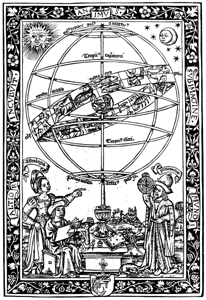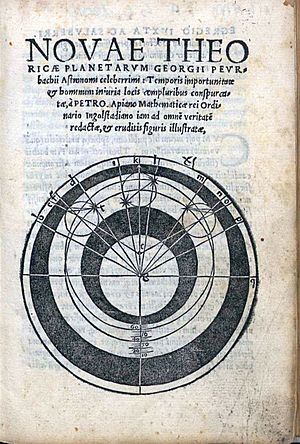Georg von Peuerbach facts for kids
Quick facts for kids
Georg von Peuerbach
|
|
|---|---|

Georg von Peuerbach: Theoricarum novarum planetarum testus, Paris 1515
|
|
| Born | May 30, 1423 Peuerbach near Linz, Duchy of Austria, Holy Roman Empire
|
| Died | April 8, 1461 (aged 37) Vienna, Archduchy of Austria, Holy Roman Empire
|
| Nationality | Austrian |
| Education | University of Vienna (B.A., 1448) |
| Known for | Reviving Ptolemaic astronomy in Europe Introducing sine tables to Europe |
| Scientific career | |
| Fields | Mathematics (trigonometry), astronomy |
| Institutions | University of Vienna |
| Academic advisors | Johannes von Gmunden |
| Notable students | Regiomontanus |
Georg von Peuerbach (born May 30, 1423 – April 8, 1461) was a very smart Austrian person. He was an astronomer (someone who studies stars and planets), a poet, a mathematician, and even made science tools.
He is most famous for his book, Theoricae Novae Planetarum. This book made the ideas of Ptolemaic astronomy (an old way of understanding the universe) much easier to understand. Peuerbach helped make astronomy, math, and literature simple for people in Europe during the Renaissance and for many years after.
Biography
We don't know much about Georg von Peuerbach's early life until he joined the University of Vienna in 1446. He was born in a town called Peuerbach in Austria. Records suggest he was born around May 30, 1423. He earned his first degree, a Bachelor of Arts, in 1448.
A local priest, Dr. Heinrich Barucher, noticed Georg's amazing intelligence when he was young. Dr. Barucher helped Georg connect with Georg Muestinger, who taught at the University of Vienna. Muestinger's lectures on planetary theory inspired Peuerbach to enroll at the university.
At the University of Vienna, Georg earned two master's degrees by 1448. He studied mathematics with Johann von Gmünden. Most of his studies were in humanities, which was common then. He learned astronomy mostly by studying on his own. Even though there were no astronomy professors at the university at the time, his work helped astronomy studies grow there.
In 1451, Peuerbach saw Jupiter disappear behind the Moon. This event marked the start of his own astronomy career. After this, he spent his life studying astronomy. He created new tools and ideas. He also worked with his student, Regiomontanus, to make astronomy easier for everyone. Most of Georg's big discoveries happened in the last ten years of his life.
Georg Peuerbach traveled around central and southern Europe, especially in Italy. He gave many lectures about astronomy. Universities like those in Bologna and Padua even offered him jobs as a professor. During his travels, he met important people like Italian astronomer Giovanni Bianchini and Cardinal Nicholas of Cusa.
He returned to the University of Vienna in 1453. He earned his Master of Arts degree and started teaching Latin poetry. He is often seen as a leader in bringing back old Greek and Roman literature to arts and sciences.
Peuerbach's love for Roman poets led him to play a big part in bringing back classical learning. He followed the advice of the court astrologer to Emperor Friedrich III and became the court astrologer for the king of Hungary. Later, he became the imperial astrologer for the Holy Roman Emperor.
In Vienna in 1454, Peuerbach taught students about how planets move. His lectures were based on the ideas of Ptolemy. These lectures became so famous that they were printed as a book called ‘Theoricae Novae Planetarum’ starting in 1472.
In 1454, Peuerbach became the court astrologer for King Ladislas V of Bohemia and Hungary. This is where he met Ladislas's cousin, Frederick, who would later become Frederick III, Holy Roman Emperor. King Ladislas lived mostly in Prague and Vienna, which allowed Peuerbach to keep teaching at the University of Vienna. During this time, Peuerbach met Regiomontanus, who was a student at the university. After Regiomontanus graduated in 1452 at age 15, he worked closely with Peuerbach on astronomy.
After some political changes, Peuerbach was asked to be the Astronomus caesaris (Emperor's Astronomer) for Emperor Frederick III. He held this important job until he passed away.
Georg von Peuerbach died on April 8, 1461. His work helped future scholars and scientists for many years. His early death was a big loss for astronomy, but his student, Regiomontanus, continued his important work.
Work
Peuerbach is best known for his book Theoricae Novae Planetarum, written in 1454. His student Regiomontanus published it in 1472. This book explained Claudius Ptolemy's geocentric system (the idea that Earth is the center of the universe) in a much clearer way. The book was based on Peuerbach's lectures in Vienna. It introduced the "New Planetary Theory," which described the physical reality of how planets moved in their orbits. For example, in his model of the sun, Peuerbach added special "partial orbs" to explain its movement.
Peuerbach's ideas replaced an older book as the main textbook for astronomy at universities. Many famous astronomers, including Nicolaus Copernicus and Johannes Kepler, studied his work.
In 1457, Peuerbach watched an eclipse. He noticed it happened 8 minutes earlier than predicted by the Alphonsine Tables, which were the best astronomy tables at the time. So, he created his own set of eclipse tables called Tabulae Eclipsium. These tables were very popular and useful for many years.
Peuerbach also wrote papers on practical mathematics and built different astronomical instruments. He created sine tables using methods from Islamic mathematicians. His work was very important for making mathematics more modern.
In 1460, Cardinal Johannes Bessarion asked Peuerbach and Regiomontanus to translate Ptolemy's Almagest from Greek into Latin. The Cardinal wanted a shorter, clearer version to use for teaching. Peuerbach agreed and worked on it with Regiomontanus until his death in 1461. They had completed 6 volumes. Regiomontanus finished the project, and the full 13-volume version was published in 1496.
Accomplishments
- In February 1453, Georg Von Peuerbach earned his Master of Arts degree in Vienna.
- He started translating Ptolemy's Almagest from Greek into Latin. His student, Regiomontanus, finished and published this important work in 1496.
- He helped expand the astronomy program at the University of Vienna.
- His observations and ideas influenced many other astronomy discoveries in Europe.
Legacy
Georg von Peuerbach's work lives on because he was so good at explaining astronomy, mathematics, and art. He made difficult ideas simple, which helped people think more deeply. Through his teaching, he created an astronomy program at his old university, helping more people learn about the stars.
Peuerbach and Regiomontanus helped Europe understand astronomy better by translating Ptolemy's Almagest. This book later influenced Nicolaus Copernicus. Even though Peuerbach died before the work was finished, Regiomontanus completed it. The Epitome of the Almagest was published in 1496. This book became a very important reference for Nicholas Copernicus when he wrote his famous book, De Revolutionibus.
It's interesting that the work of Nicolaus Copernicus and later Sir Isaac Newton actually showed that many of the ideas Peuerbach supported (like the Earth being the center of the universe) were wrong. However, Peuerbach's improvements in tools and theories still helped make the study of astronomy more modern.
Peuerbach's contributions to Regiomontanus's math tables were used by astronomers for the next hundred years. His full observations were published almost a century after his death. His book Theoricae Novae Planetarum was printed many times between 1472 and 1596. It was one of the most common astronomy textbooks for training future scholars. It helped establish much of the technical words used by astronomers for a long time.
Peuerbach also created tables that could predict eclipses of both the sun and the moon. His student Regiomontanus continued this practice. These tables were still used by astronomers like Tycho Brahe much later. He also helped collect and copy many astronomy writings. This led to the creation of a scientific printing press in Nuremberg by Regiomontanus. This press was used to publish important astronomy books, including Peuerbach's own Theoricae Novae Planetarum.
Works
- Tabulae eclipsium (in Latin). These were tables from 1459 that helped predict eclipses.
- Peurbach, Georg and Regiomontanus, Tractatus Georgi Peurbachii super propositiones Ptolemaei de sinubus & chordis (A treatise of George Peurbach on the propositions of Ptolemy concerning the sines and chords), Johann Petreius, Germany, 1468.
See also
 In Spanish: Georg von Peuerbach para niños
In Spanish: Georg von Peuerbach para niños




